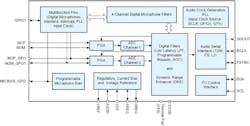Feature-Packed Automotive Audio ADC Sports 123-dB SNR, 768-kHz Rate
Automotive audio functions and performance receive lots of attention, especially with respect to higher-power audio amplifiers featuring ultra-low total harmonic distortion (THD) and related specifications. Obviously, high-performance digital-to-analog converters (DACs) are key elements in audio-output signal chain. But today’s cars go far beyond creating sound, as they must also capture and digitize it with accuracy and high signal-to-noise ratio (SNR) from two or more microphones.
Targeting these applications is the Texas Instruments PCM6120-Q1, a stereo automotive audio analog-to-digital converter (ADC) specified at 123-dB SNR with its dynamic range enhancer (DRE) enabled (and 113-dB with DRE disabled) and 768-kHz maximum sampling rate.
Applications include automotive active-noise cancellation, “head” units, rear-seat entertainment, digital-cockpit processing units, and even the telematics control unit. Non-automotive applications range from voice-activated systems, professional microphones, audio conferencing, and portable computing to communication and entertainment designs.
Simply saying this is “just another high-end audio ADC” misses its many attributes beyond core signal-domain conversion. This ADC IC is a highly integrated and complex component with many features, I/O options, and capabilities that add to its functionality, and most of them are software-programmable and controllable (Fig. 1).
Also note that TI has designated this as a Burr-Brown converter, harking back to the long-standing legacy and reputation of that company which TI acquired in 2000.
The PCM6120-Q1 supports simultaneous sampling of up to two analog channels or four digital channels for the pulse-density-modulation (PDM) microphone input. The device offers line and microphone inputs, and it allows for both single-ended and differential-input configurations.
Software Programmability
Nearly every function or feature is software programmable: channel gain, digital volume control, microphone bias voltage, phase-locked loop (PLL), high-pass filter (HPF), biquad filters, and low-latency filter modes. For formats and I/O, it allows for time-division multiplexing (TDM), I2S, or left-justified (LJ) audio formats, and can be controlled with its I2C interface.
Along with this level of functionality and complexity comes the need to “do your homework,” so to speak, as evidenced by the 124-page datasheet and the amount of studying required to understand and fully exercise its capabilities.
Fortunately, TI addressed that issue as well via hardware and software. Its ADC6120Q1EVM-PDK evaluation module (Fig. 2), which costs $199, is used to exercise the PCM6120-Q1 when paired with the AC-MB, a flexible motherboard that provides power, control and digital audio data to the EVM.
However, a fully programmable component such as this one needs more than just a hardware EVM, so TI offers the PurePath Console graphical development suite for audio-system design and development. Its many advanced control features are implemented in an easy-to-use graphical interface (GUI) designed to reduce product-development time, even for those who aren’t audio experts.
The low-power PCM6120-Q1 operates from a single supply at 3.3 or 1.8 V; power consumption using a 1.8-V AVDD supply is 9.5 mW/channel at a 48-kHz sample rate. It’s specified from –40 to +125°C and comes in a 20-pin WQFN package (3 × 3 mm, with 0.5-mm pitch); other packages are available as well. The IC is priced at $4.40 in 1,000-piece lots.
About the Author

Bill Schweber
Contributing Editor
Bill Schweber is an electronics engineer who has written three textbooks on electronic communications systems, as well as hundreds of technical articles, opinion columns, and product features. In past roles, he worked as a technical website manager for multiple topic-specific sites for EE Times, as well as both the Executive Editor and Analog Editor at EDN.
At Analog Devices Inc., Bill was in marketing communications (public relations). As a result, he has been on both sides of the technical PR function, presenting company products, stories, and messages to the media and also as the recipient of these.
Prior to the MarCom role at Analog, Bill was associate editor of their respected technical journal and worked in their product marketing and applications engineering groups. Before those roles, he was at Instron Corp., doing hands-on analog- and power-circuit design and systems integration for materials-testing machine controls.
Bill has an MSEE (Univ. of Mass) and BSEE (Columbia Univ.), is a Registered Professional Engineer, and holds an Advanced Class amateur radio license. He has also planned, written, and presented online courses on a variety of engineering topics, including MOSFET basics, ADC selection, and driving LEDs.


